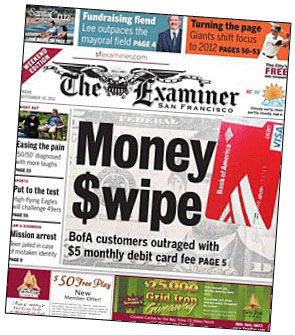Banks all over the country, led by Bank of America, are announcing new monthly fees for customers who use debit cards. Why? Because new laws restrict both the insanely high overdraft fees they used to charge and the “swipe fee” they tack on to every transaction — so they’re making up for the lost revenue elsewhere. “Thanks Dick!” is a typical reaction, because  the new rules are the brainchild of Sen. Dick Durbin. In San Francisco, where I am today, the Examiner puts things a little more colorfully.
the new rules are the brainchild of Sen. Dick Durbin. In San Francisco, where I am today, the Examiner puts things a little more colorfully.
If you want to know why so many people hate liberals, this is it. We’re annoying! And now, thanks to us, you have to pay a monthly fee to use your debit card.
Unfortunately, it’s hard to explain why this is, nonetheless, a good thing. But here’s the nickel version: the old fees were largely hidden. The new ones aren’t. Overdraft fees were deliberately designed to be unpredictable, unforeseen, and primarily aimed at low-income users. Swipe fees were invisible because the credit card industry is effectively a duopoly and prohibits merchants from adding swipe fees to credit card bills. After all, if they did that, consumers might actually see what they were really paying for the privilege of using credit and debit cards.
All along, banks have had the option of reforming overdraft fees to make them fairer and more transparent. They had the option of allowing merchants to charge customers for swipe fees or not as they preferred. But they didn’t. That’s because hidden fees, on average, are more lucrative. Hidden or not, though, we’re all still paying them.
So yes: the new fees are annoying. But that’s a feature, not a bug, because now they’re right up front in black and white, which means that consumers will see them and can be properly outraged (or not) by them. This in turn means that the free market has a chance to actually work: consumers will abandon Bank of America if their fees are too high and force them to charge less. Likewise, other banks will compete openly on the size of their fees. In the end, this competition will force fees down to the lowest possible profitable level, which is exactly what competition is supposed to.
It may not seem like much of a blessing at first, and lots of people will remain annoyed at us annoying liberals for introducing this new annoyance into their lives. But if you actually believe that competition is good for consumers and eventually produces lower prices and better service, you should welcome these new fees. Banks liked the cozy old system, where everything was hidden and competition remained subdued. Consumers should like the new one.
UPDATE: Want an even shorter explanation? Here it is: banks hate the new rules. But do you seriously think they’d hate a rule that was going to increase costs to consumers and thereby put more money in their own pockets? Of course not. Obviously they believe that consumers are the ones who are going to benefit, not banks, and who would know better?















